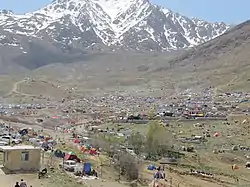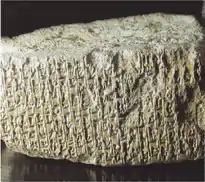Hafshejan
Hafshejan (Persian: هفشجان, also Romanized as Hafshejān and Hafeshjān; also known as Hosheh Gūn, Hushegūn, and Jasteh Jūn)[2] is a city in the Central District of Shahrekord County, Chaharmahal and Bakhtiari Province, Iran. At the time of the 2016 census, its population was 21,352, in 6,655 families
Hafshejan
هفشجان | |
|---|---|
City | |
 | |
 Hafshejan | |
| Coordinates: 32°13′32″N 50°47′38″E | |
| Country | |
| Province | Chaharmahal and Bakhtiari |
| County | Shahrekord |
| Bakhsh | Central |
| Population (2016 Census) | |
| • Total | 21,352 [1] |
| Time zone | UTC+3:30 (IRST) |
| • Summer (DST) | UTC+4:30 (IRDT) |
| Website | http://www.hafshejan.com |
Hafshejan has existed for around 9000 years.[3] This region in the Gajjar time was under the domination of Bakhtiaris, but after stabilization of central power, the power of the Bakhtiaris was reduced.
Locals call this city Hoshegoon or Heyshegoon.
Historically, many people in Hafshejani were char-va-dar in ancient times, which means a person who owns pack animals and carries goods for trading. Others were farmers and used the waters of several springs to grow their crops. Later it became famous in Iran for its skillful welders.At the moment, most of the men in Hafeshjan work on oil and gas projects in Iran and other countries especially in the field of pipelines and piping and construction of storage tanks. Hafeshjan is known in Iran as the Welding capital of Iran and the application for global registration has been made in UNESCO as the capital of the world welding industry. You can not find a project in Iran that some of the men in this city are not working there.
Geography
One of the most well-known places in Hafshejan is a spring called Cheshme Zane; the name means eyes of birth or eyes at birth - implying a new and beautiful site to behold.
 9000 years streak of mud Eskandari Hafshejan hill
9000 years streak of mud Eskandari Hafshejan hill
Zaneh Hafshejan fountain walkway
Hafshejan walkway is in the Jahanbin mountain range and is located 2 km from Hafshejan and 20 km from Kord. On Nature Day each year, more than 10 thousand people visit the park fountain.[4]
A walkway extends from the main Tourist attraction near the current centre of Chaharmahal and Bakhtiari Province, Shahr-e Kord.
Water is routed from the fountain to the agricultural plains 20 kilometres south of Branch and north of the mountain barrier between the world and 3 km from the city. The earthen dam has a clay core, and the reservoir has a volume of 1.3 million cubic meters. The dam crest's length is 410 m and the crest's width is 8 m, with a height of 42 meters in the deepest area.[5]
Elamite brick

The Hafshejan Elamite brick carries the ancient scrolls of Chaharmahal and Bakhtiari Province. After the inscription is written Hafshejan. This brick has a width of 15 cm, a diameter of 8 cm, and has 26 lines. It was created more than 3100 years ago (1120 BC. M.). The brick was discovered in the province of Chaharmahal and Bakhtiari Province in the afternoon Elamite shows[6]
Gallery
 The oldest lions made of stone in Hafshejan
The oldest lions made of stone in Hafshejan A 6000-year-old inscription in Hafshejan
A 6000-year-old inscription in Hafshejan
See also
References
- https://www.amar.org.ir/english
- Hafshejan can be found at GEOnet Names Server, at this link, by opening the Advanced Search box, entering "-3065354" in the "Unique Feature Id" form, and clicking on "Search Database".
- Zagarell, A. (1982). The Prehistory of the Northeast Bakhtiari Mountains, Iran “The Rise of a Highland Way of Life
- "چهارمحال و بختیاری بام ایران ، سرزمین هزار چشمه + تصاویر - اخبار تسنیم - Tasnim". خبرگزاری تسنیم - Tasnim (in Persian). Retrieved 2018-05-08.
- «چهارمحال و بختیاری بام ایران، سرزمین هزار چشمه + تصاویر»
- "Archived copy". Archived from the original on 2016-08-22. Retrieved 2016-07-10.CS1 maint: archived copy as title (link)
